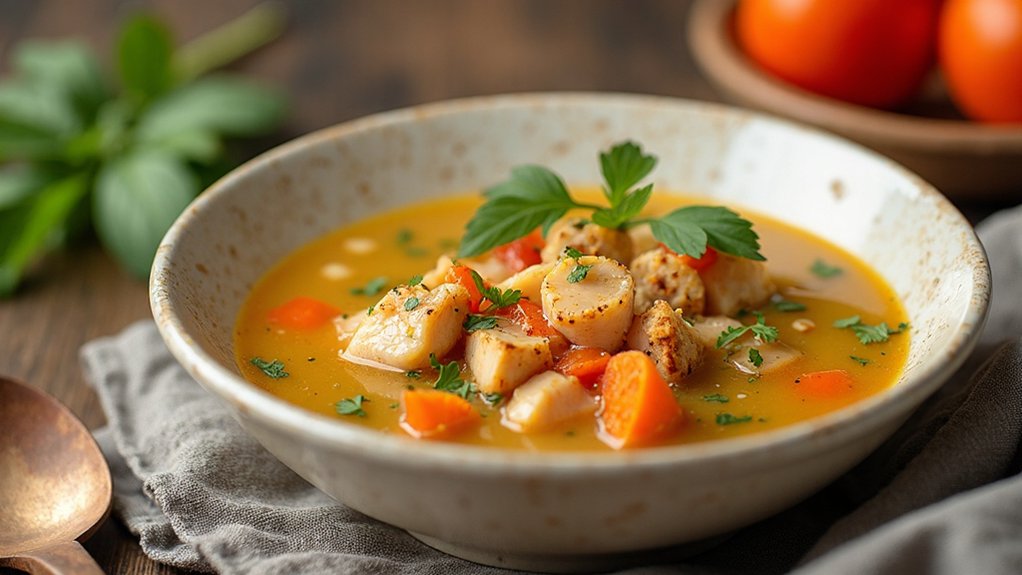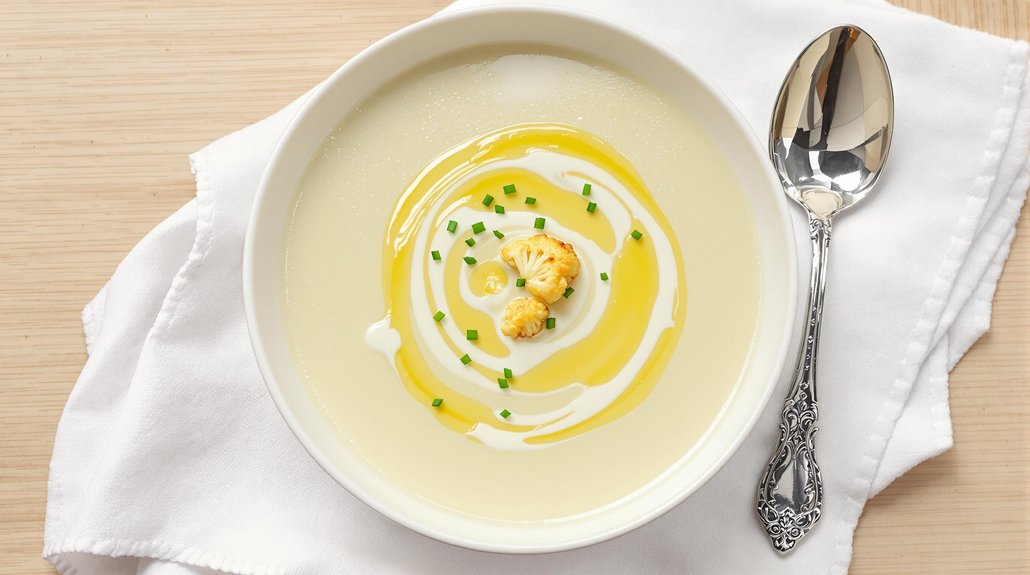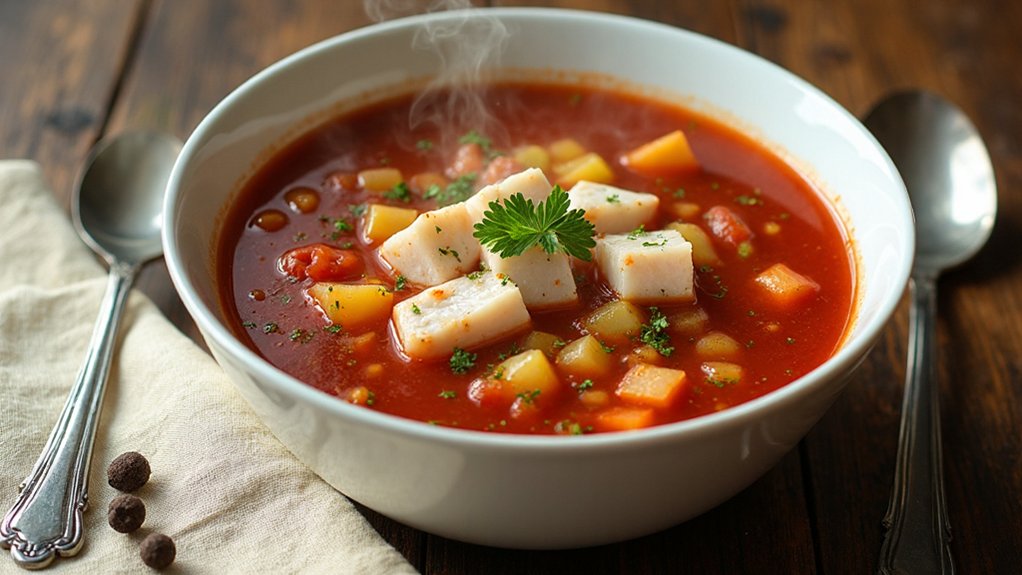I’m convinced that store-bought chicken stock is just expensive salty water masquerading as flavor, and honestly, you deserve better. Making your own homemade chicken stock isn’t rocket science, though I’ll admit it requires more patience than I typically possess on a Tuesday afternoon. The thing is, once you smell that rich, golden liquid simmering away on your stove, you’ll understand why this simple process transforms ordinary ingredients into liquid gold that’ll make your future soups sing.
Why you’ll love this dish
When you’re craving that soul-warming comfort that only comes from a steaming bowl of homemade chicken soup, nothing beats starting with your own rich, golden stock.
I’m telling you, this recipe transforms your kitchen into a cozy haven that’ll make your neighbors mysteriously start dropping by around dinnertime.
The slow-roasted vegetables create layers of flavor that store-bought stock simply can’t match. Plus, you control every ingredient, no mysterious additives or sodium overload.
The overnight simmering fills your home with the most incredible aroma. Trust me, once you taste this liquid gold, you’ll never go back to the boxed stuff.
Ingredients
This chicken stock recipe might look like it calls for half your grocery store, but trust me, every single ingredient has a purpose in creating that rich, restaurant-quality broth you’re after.
The beauty of this recipe lies in how each component builds upon the others, creating layers of flavor that’ll make your taste buds do a little happy dance.
- 1 frying chicken, trimmed of all visible fat and cut into pieces
- 2 large onions, unpeeled and quartered
- 4 carrots, quartered
- 4 stalks celery, cut into chunks
- 2 turnips, scrubbed and quartered
- 1/2 cup parsley
- 2 large leeks
- 10 peppercorns
- 10 whole cloves
- 3 garlic cloves
- Extra chicken pieces (backs, necks, wing tips, etc.)
- 1 tablespoon poultry seasoning
Don’t panic if you can’t find every single ingredient on your first grocery run. The extra chicken bits might require a special request from your butcher, but they’re worth the effort since they’re packed with collagen that gives your stock that silky, luxurious mouthfeel.
Those turnips might seem like an odd addition, but they add a subtle earthiness that rounds out the flavor profile beautifully.
And here’s a pro tip: keep those onion skins on because they’re the secret to that gorgeous golden color that makes your stock look like it came straight from a fancy restaurant kitchen.
Directions

Now comes the fun part, and by fun, I mean the part where you’ll wonder why you didn’t start this recipe yesterday because good things take time. First, you’ll want to prep those 2 large leeks by cutting the white and light green parts into large chunks and washing them thoroughly – and I mean thoroughly, because leeks love to hide dirt in their layers like it’s their full-time job. Save those green parts though, they’re going to be your secret weapon later.
Toss your cut-up frying chicken, along with those 2 large unpeeled onion quarters, 4 quartered carrots, 4 chunked celery stalks, and 2 scrubbed turnip quarters into a large roasting pan. Sprinkle everything with that 1 tablespoon of poultry seasoning and pop it into a 350-degree oven for one hour. Your kitchen is about to smell absolutely incredible, so maybe warn the neighbors or they’ll start showing up at dinnertime.
While that’s roasting away, fill your largest stock pot halfway with water – we’re talking a 20-gallon monster if you’ve got one, because this recipe doesn’t mess around. Once your vegetables and chicken have had their hour-long spa treatment in the oven, dump the entire contents of that roasting pan into your water-filled pot, then add more water until you hit the three-quarters mark.
Now add your remaining ingredients: those leek whites you prepped earlier, 1/2 cup parsley, 10 peppercorns, 10 whole cloves, 3 garlic cloves, and any extra chicken pieces you managed to sweet-talk from your butcher. Here’s where patience becomes your best friend – bring this gorgeous mess very slowly to a boil on medium heat, and watch it like you’re binge-watching your favorite show because you’ll need to skim off any froth or scum that decides to crash the party.
The moment you see those first little bubbles starting to form, turn that heat down to the lowest possible setting because we’re simmering, not boiling – there’s a difference, and your stock will thank you for knowing it. Take those saved leek greens and lay them across the top like a green blanket, then place your lid slightly askew on the pot.
Now comes the hardest part: waiting. Let this beauty simmer for at least 4 hours, though overnight is even better if you can manage it. Once it’s done, you’ll cool it down, fish out all the solids and toss them, then strain the whole thing through cheesecloth. Skim off any fat that rises to the top, and congratulations – you’ve just made liquid gold that’ll make every soup, stew, and risotto sing with flavor. If you plan to make stock regularly or want to process leftover chicken for future recipes, a quality meat grinder can help you maximize every bit of your poultry investment.
Substitutions and Variations
Look, I get it – not everyone has a 20-gallon stockpot sitting around their kitchen like some sort of commercial soup operation, and maybe you don’t want to commit to roasting a whole chicken when you’ve got perfectly good rotisserie leftovers staring at you from the fridge.
Use whatever pot you’ve got, even if it’s just eight quarts. Skip the roasting step entirely and toss everything straight into the pot.
No turnips? Fine. Extra celery? Great. I’m not the soup police.
The beauty of stock-making is its forgiving nature – it’ll taste amazing regardless of your shortcuts.
Additional Things to Serve With This Dish
Once you’ve got this liquid gold simmering away in your kitchen, you’ll want to think about what’s going swimming in that beautiful broth.
I love tossing in tender egg noodles, fluffy dumplings, or even leftover rice for heartiness. Fresh herbs like dill or thyme add brightness, while diced carrots and celery bring back those classic soup vibes.
Want something fancy? Try wild rice or orzo pasta. Don’t forget crusty bread for dunking – because what’s soup without something to soak up every last drop?
The beauty lies in making it yours with whatever’s hanging around your pantry.
Final Thought
While this recipe might seem like a marathon effort with all that roasting and simmering, I promise you’ll taste the difference in every spoonful.
Sure, you could grab store-bought stock, but where’s the soul in that? This homemade version has layers of flavor that’ll make your kitchen smell like pure comfort.
The overnight simmer? That’s where the magic happens. I’m telling you, once you’ve got this golden liquid treasure in your freezer, you’ll never look at canned broth the same way.
Your soups will thank you, and honestly, so will anyone lucky enough to taste them.








